人教版(2019) 选择性必修二 Unit 1 Science and Scientists Reading and Thinking课件(共40张PPT)
文档属性
| 名称 | 人教版(2019) 选择性必修二 Unit 1 Science and Scientists Reading and Thinking课件(共40张PPT) | 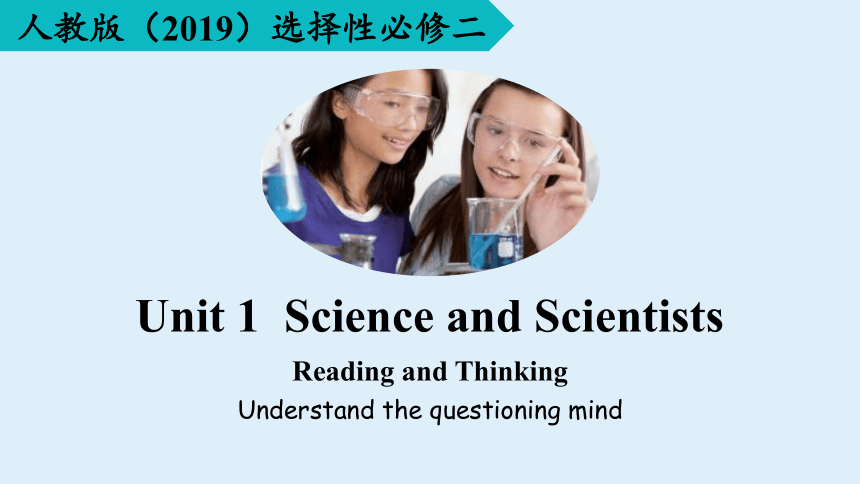 | |
| 格式 | pptx | ||
| 文件大小 | 9.8MB | ||
| 资源类型 | 教案 | ||
| 版本资源 | 人教版(2019) | ||
| 科目 | 英语 | ||
| 更新时间 | 2023-08-17 13:21:27 | ||
图片预览

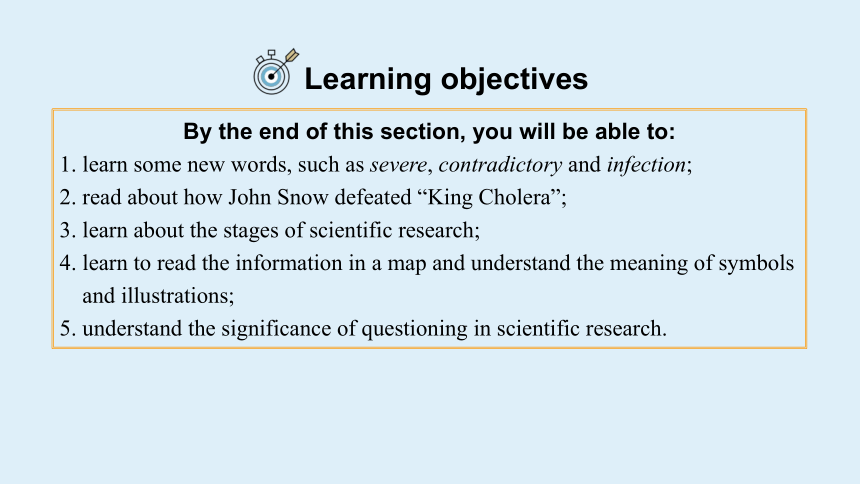
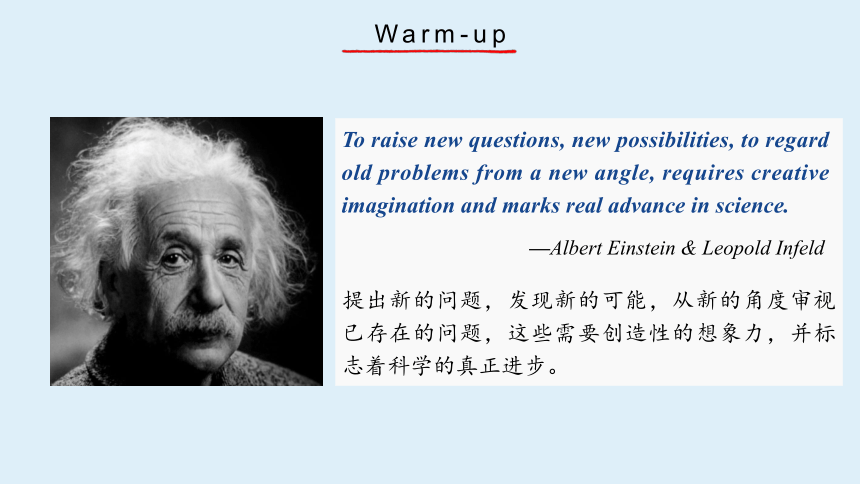
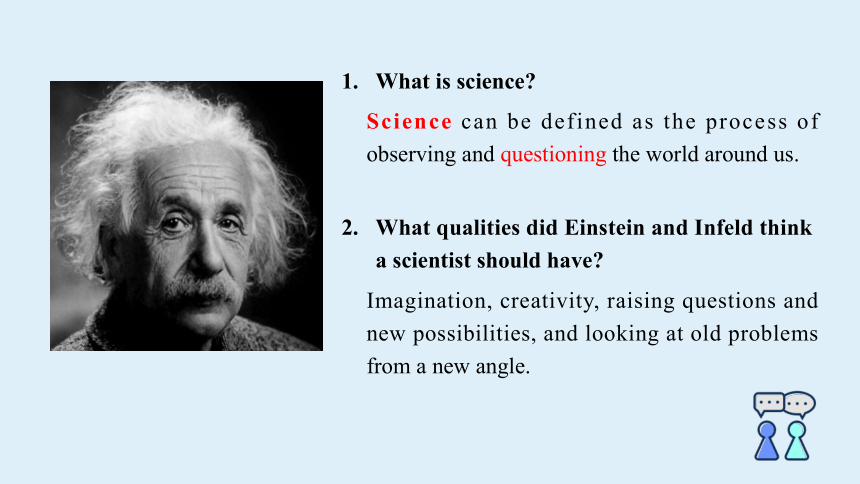
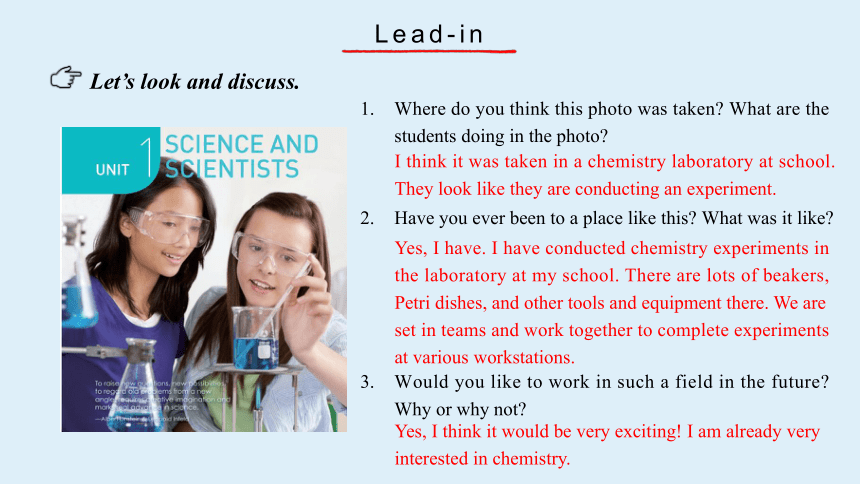
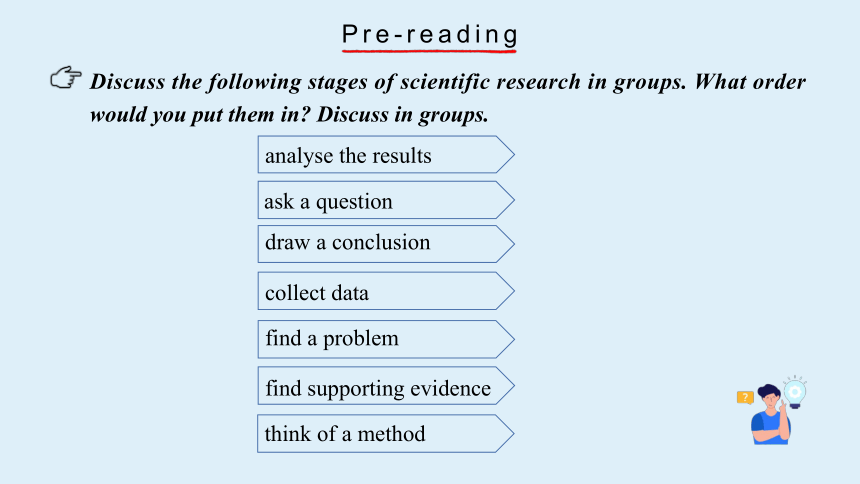
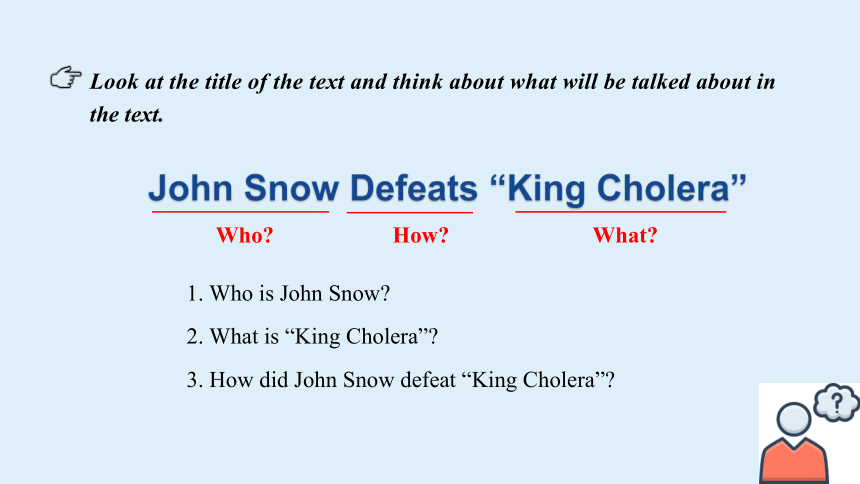
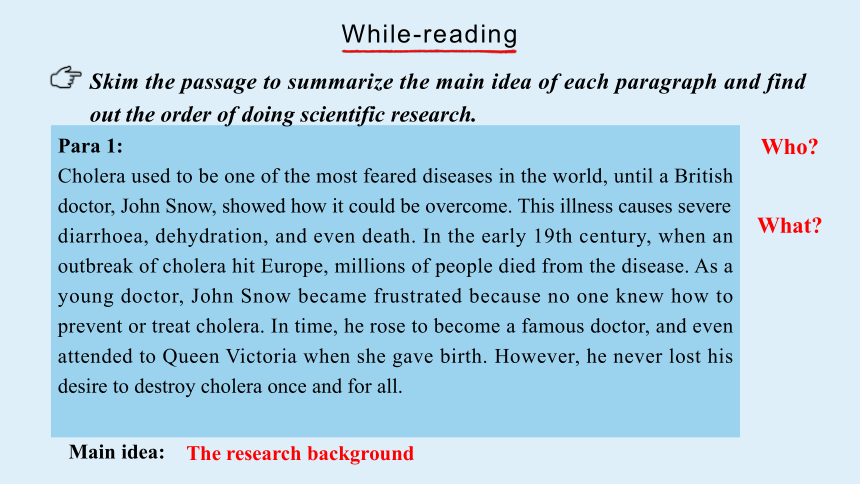
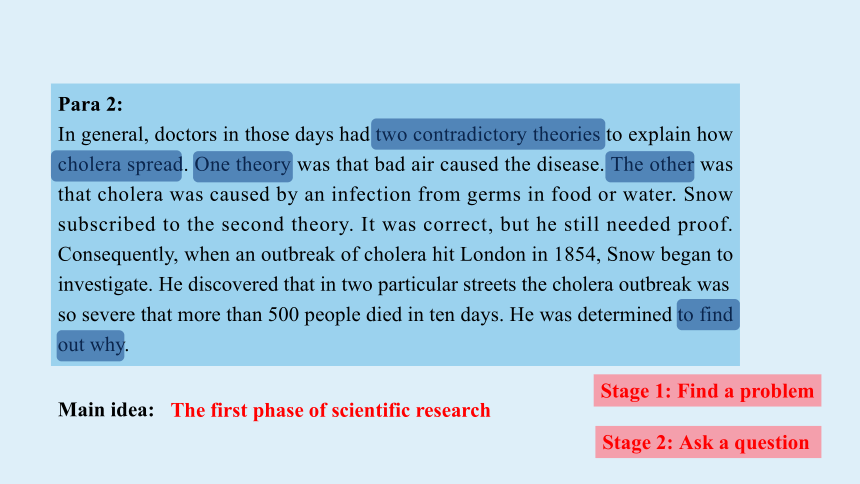
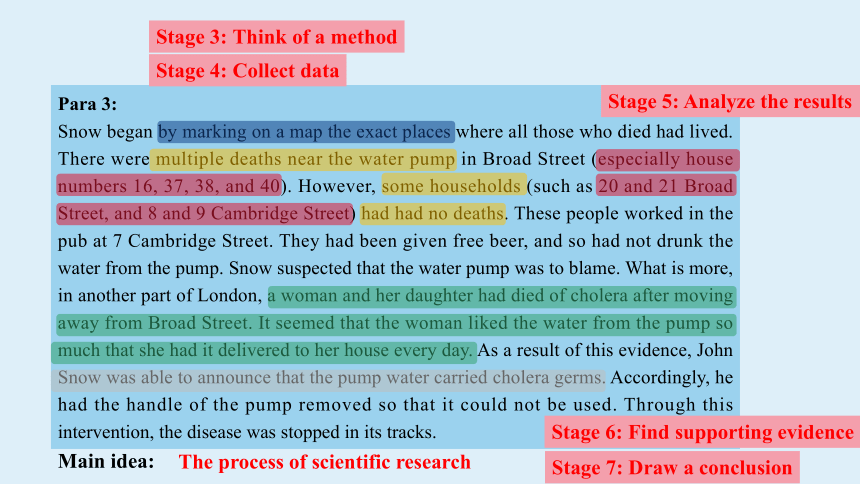
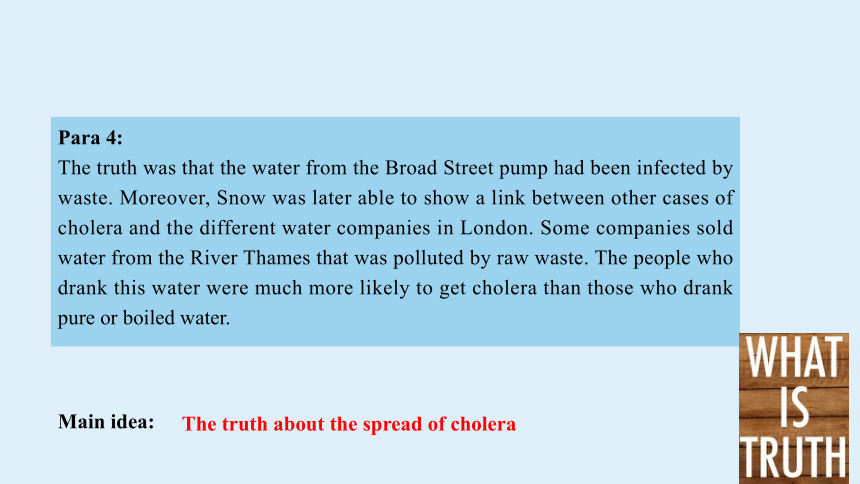
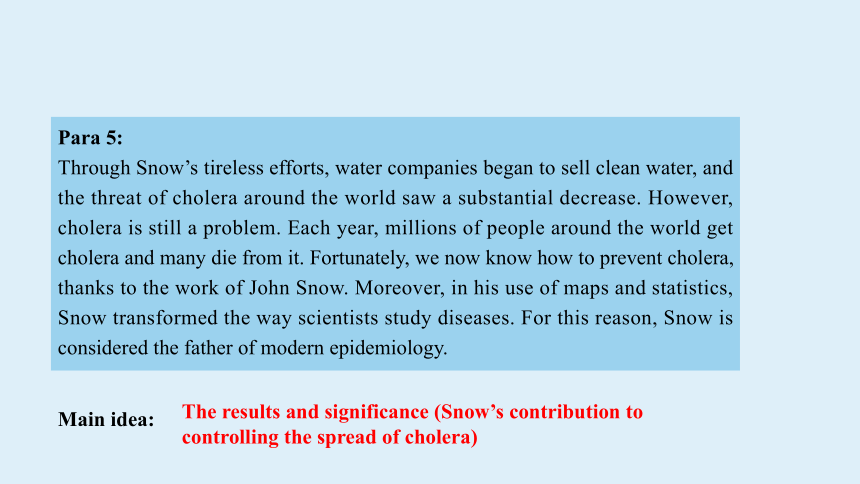
文档简介
(共40张PPT)
人教版(2019)选择性必修二
Unit 1 Science and Scientists
Reading and Thinking
Understand the questioning mind
Learning objectives
By the end of this section, you will be able to:
1. learn some new words, such as severe, contradictory and infection;
2. read about how John Snow defeated “King Cholera”;
3. learn about the stages of scientific research;
4. learn to read the information in a map and understand the meaning of symbols
and illustrations;
5. understand the significance of questioning in scientific research.
To raise new questions, new possibilities, to regard old problems from a new angle, requires creative imagination and marks real advance in science.
—Albert Einstein & Leopold Infeld
提出新的问题,发现新的可能,从新的角度审视已存在的问题,这些需要创造性的想象力,并标志着科学的真正进步。
Warm-up
What is science
Imagination, creativity, raising questions and new possibilities, and looking at old problems from a new angle.
What qualities did Einstein and Infeld think a scientist should have
Science can be defined as the process of observing and questioning the world around us.
Let’s look and discuss.
Lead-in
Where do you think this photo was taken What are the students doing in the photo
Have you ever been to a place like this What was it like
Would you like to work in such a field in the future Why or why not
Yes, I have. I have conducted chemistry experiments in the laboratory at my school. There are lots of beakers, Petri dishes, and other tools and equipment there. We are set in teams and work together to complete experiments at various workstations.
I think it was taken in a chemistry laboratory at school. They look like they are conducting an experiment.
Yes, I think it would be very exciting! I am already very interested in chemistry.
Discuss the following stages of scientific research in groups. What order would you put them in Discuss in groups.
Pre-reading
draw a conclusion
ask a question
analyse the results
collect data
find a problem
find supporting evidence
think of a method
Look at the title of the text and think about what will be talked about in the text.
John Snow Defeats “King Cholera”
Who
What
How
1. Who is John Snow
2. What is “King Cholera”
3. How did John Snow defeat “King Cholera”
Para 1:
Cholera used to be one of the most feared diseases in the world, until a British doctor, John Snow, showed how it could be overcome. This illness causes severe diarrhoea, dehydration, and even death. In the early 19th century, when an outbreak of cholera hit Europe, millions of people died from the disease. As a young doctor, John Snow became frustrated because no one knew how to prevent or treat cholera. In time, he rose to become a famous doctor, and even attended to Queen Victoria when she gave birth. However, he never lost his desire to destroy cholera once and for all.
Main idea:
The research background
Who
What
Skim the passage to summarize the main idea of each paragraph and find out the order of doing scientific research.
While-reading
Para 2:
In general, doctors in those days had two contradictory theories to explain how cholera spread. One theory was that bad air caused the disease. The other was that cholera was caused by an infection from germs in food or water. Snow subscribed to the second theory. It was correct, but he still needed proof. Consequently, when an outbreak of cholera hit London in 1854, Snow began to investigate. He discovered that in two particular streets the cholera outbreak was so severe that more than 500 people died in ten days. He was determined to find out why.
Stage 2: Ask a question
Stage 1: Find a problem
Main idea:
The first phase of scientific research
Para 3:
Snow began by marking on a map the exact places where all those who died had lived. There were multiple deaths near the water pump in Broad Street (especially house numbers 16, 37, 38, and 40). However, some households (such as 20 and 21 Broad Street, and 8 and 9 Cambridge Street) had had no deaths. These people worked in the pub at 7 Cambridge Street. They had been given free beer, and so had not drunk the water from the pump. Snow suspected that the water pump was to blame. What is more, in another part of London, a woman and her daughter had died of cholera after moving away from Broad Street. It seemed that the woman liked the water from the pump so much that she had it delivered to her house every day. As a result of this evidence, John Snow was able to announce that the pump water carried cholera germs. Accordingly, he had the handle of the pump removed so that it could not be used. Through this intervention, the disease was stopped in its tracks.
Stage 4: Collect data
Main idea:
The process of scientific research
Stage 3: Think of a method
Stage 5: Analyze the results
Stage 7: Draw a conclusion
Stage 6: Find supporting evidence
Main idea:
Para 4:
The truth was that the water from the Broad Street pump had been infected by waste. Moreover, Snow was later able to show a link between other cases of cholera and the different water companies in London. Some companies sold water from the River Thames that was polluted by raw waste. The people who drank this water were much more likely to get cholera than those who drank pure or boiled water.
The truth about the spread of cholera
Main idea:
The results and significance (Snow’s contribution to controlling the spread of cholera)
Para 5:
Through Snow’s tireless efforts, water companies began to sell clean water, and the threat of cholera around the world saw a substantial decrease. However, cholera is still a problem. Each year, millions of people around the world get cholera and many die from it. Fortunately, we now know how to prevent cholera, thanks to the work of John Snow. Moreover, in his use of maps and statistics, Snow transformed the way scientists study diseases. For this reason, Snow is considered the father of modern epidemiology.
stages of scientific research
7. draw a conclusion
1. find a problem
2. ask a question
6. find supporting evidence
5. analyse the results
3. think of
a method
4. collect data
structure of the text
Paragraph Main idea
1
2-3
4
5
Background (Who is John Snow )
(What is King Cholera )
How (the process)
The Truth
Results and Significance
Read paragraph 1 carefully and finish the mind maps below.
1. What It is one of _________
________________________
because it causes __________
________________________
______________.
2. When
________________________
3. Where
________________________
4. What consequence
________________________
cholera
Cholera used to be one of the most feared diseases in the world, until a British doctor, John Snow, showed how it could be overcome. This illness causes severe diarrhoea, dehydration, and even death. In the early 19th century, when an outbreak of cholera hit Europe, millions of people died from the disease. As a young doctor, John Snow became frustrated because no one knew how to prevent or treat cholera. In time, he rose to become a famous doctor, and even attended to Queen Victoria when she gave birth. However, he never lost his desire to destroy cholera once and for all.
the most
feared diseases in the world
severe
diarrhoea, dehydration, and even death
In the early 19th century.
In Europe.
Millions of people died.
Read paragraph 1 carefully and finish the mind maps below.
1. Who A ________________
doctor who even attended to
________________________
when she gave birth.
2. What He had a desire to
________________________
once and for all.
John Snow
Cholera used to be one of the most feared diseases in the world, until a British doctor, John Snow, showed how it could be overcome. This illness causes severe diarrhoea, dehydration, and even death. In the early 19th century, when an outbreak of cholera hit Europe, millions of people died from the disease. As a young doctor, John Snow became frustrated because no one knew how to prevent or treat cholera. In time, he rose to become a famous doctor, and even attended to Queen Victoria when she gave birth. However, he never lost his desire to destroy cholera once and for all.
young and famous
destroy cholera
Queen Victoria
Learn to read the map on Page 2.
1. What kind of map is it
2. What does “__” mean
3. What does “PH” mean
4. What does 30, 31, ... refer to
5. How many deaths were there in house
number 19 in Broad Street
6. Which house numbers had more than
four deaths in Broad Street
7. Which house numbers had no deaths in
Broad Street
8. Where is the pump
Note
—: 1 death
PH: public house
30, 31, …: numbers of houses
Public house.
It’s Snow’s cholera map.
1 death.
Numbers of houses.
2.
Near house number 40 in Broad Street.
14, 20, 21, 25, 27, 28, and 34.
16, 37, 38, and 40.
Read the passage again and complete the chart below. Match the following headers with the letters from the chart. Write A-E in the blanks.
It was believed that Cholera was caused by bad _______ or germs in _____________.
Snow _________________ the places where the people who ______ had lived.
Many deaths occurred near the ____________ in Broad Street.
Some people ______ drunk the water from the pump, and lived.
A woman and her daughter died in another part of London after __________________________.
The pump water carried ___________.
The _______ of the pump was removed.
A
B
C
E
D
1. conclusion ___ 2. evidence ___ 3. process ___ 4. solution ___ 5. theories ___
air
food or water
marked on a map
died
water pump
hadn’t
cholera germs
handle
moving away from Broad Street
D
C
B
E
A
1. Q: What _______________________________________
A: Snow thought that cholera was caused by germs in food
or water.
2. Q: Why _______________________________________
A: Snow had the handle of the pump removed so that it
could not be used.
3. Q: How _______________________________________
A: The cholera threat was defeated thanks to the work of
John Snow.
did Snow think cholera was caused by
did Snow have the handle of the pump removed
was the cholera threat defeated
Post-reading
Write out the questions according to the answers.
Ask questions
One way to approach a reading passage is to ask questions about it. Asking questions can help you understand the content. It can also help you think more deeply about the topic.
In groups, discuss the following questions.
What was the most important tool Snow used to defeat cholera What common medical tools, e.g., a microscope, didn’t he use Why
He used maps and statistics to analyse where the deaths occurred. He didn’t use a microscope, for example. He didn’t test the water, nor did he draw blood or examine patients.
The reason he did not use medical equipment such as a microscope was because they did not exist during his time. Further, understanding of germs and bacteria was still developing, and so he had to innovate methods himself based on the theory he believed.
In groups, discuss the following questions.
How has John Snow’s work affected our daily lives
Snow’s work has provided readily available clean water to drink, for example, as well as an emphasis on hygiene such as the need to wash hands after they become dirty. He also showed how to prevent cholera epidemics, and transformed the way scientists study diseases, which has allowed for more protection from once common diseases such as cholera.
Words and Expressions
This illness causes severe diarrhoea, dehydration, and even death. (P2)
它可导致严重腹泻、脱水甚至死亡。
severe /s v (r)/ adj. 极为恶劣的;十分严重的;严厉的
例句
She suffered from severe depression after losing her job.
她失业后患了严重的抑郁症。
Even petty mistakes could bring on severe punishment.
就算是小错也可能带来严厉的惩罚。
We delayed our hiking due to the severe weather conditions.
由于天气恶劣,我们推迟了徒步旅行。
拓展
severely adv. 严重地;严厉地 severity n. 严重性
1
However, he never lost his desire to destroy cholera once and for all. (P2)
然而,他始终没有放弃彻底根除霍乱的愿望。
once and for all 最终地;彻底地
例句
We need to settle this once and for all.
我们需要把这事一次解决。
He called this a once and for all decision.
他称这是不可改变的决定。
2
In general, doctors in those days had two contradictory theories to explain how
cholera spread. (P2)
关于霍乱的蔓延方式,当时医生大体上有两种截然不同的看法。
contradictory / k ntr d kt ri/ adj. 相互矛盾的;对立的;不一致的
例句
The advice I received was often contradictory.
我所得到的建议常常是相互矛盾的。
It was contradictory to the existing facts.
那与存在的事实相矛盾。
拓展
contradiction n. 矛盾;不一致
3
The other was that cholera was caused by an infection from germs in food or water.
(P2)
另一种看法是食物或饮用水中的细菌感染导致霍乱。
infection / n fek n/ n. 感染;传染
搭配
mild/slight/severe infection 轻微感染/严重感染
例句
It could lead to infection and other problems. 它可能会导致感染或其他问题。
A cold is an infection of the upper respiratory tract. 感冒是上呼吸道的感染。
拓展
infect vt. 使感染;使传染 infectious adj. 传染的;传染性的
4
Snow subscribed to the second theory. (P2)
斯诺赞同第二种看法。
subscribe /s b skra b/ vi. 认购(股份);定期订购;定期交纳(会费)
搭配
subscribe to 同意;赞同
subscribe to the view/belief/theory 赞同观点/信念/理论
例句
I subscribed to a journal this year. 今年我订了一份期刊。
We do not subscribe to this theory. 我们不认同这项理论。
拓展
subscriber n. 订阅者;消费者;用户 subscription n. 订阅(费);会费
5
It was correct, but he still needed proof. (P2)
这一看法是正确的,但他仍需要证据。
proof /pru f/ n. 证据;证明;检验
搭配
positive/conclusive proof 确切的/确凿的证据
living proof 活生生的例证
例句
Keep your receipt as proof of purchase. 保存好收据作为购货凭证。
You have no proof of my involvement in anything.
你没有证据证明我参与了任何活动。
拓展
prove v. 证明,证实;证明是
6
There were multiple deaths near the water pump in Broad Street (especially house
numbers 16, 37, 38, and 40). (P2)
宽街水泵附近有多例死亡(尤其是16号、37号、38号及40号住宅)。
multiple / m lt pl/ adj. 数量多的;多种多样的 n. 倍数
搭配
multiple choice 多项选择的
multiple store 连锁商店
例句
She is a multiple job holder.
她是个兴趣多样的职业者。
14, 21 and 28 are all multiples of 7.
14、21和28都是7的倍数。
7
Snow suspected that the water pump was to blame. (P2)
斯诺怀疑水泵是罪魁祸首。
blame /ble m/ vt. 责怪;指责;把……归咎于 n. 责备;指责
搭配
blame sb/sth for sth 因某事责怪某人/某事
blame sth on sb/sth 把某事的责任归咎于某人/某事
sb/sth is to blame (for sth) 某人/某物(对某事)负有责任
take/accept the blame 承担责任,承认是自己的错
share the blame 共同承担责任
例句
Nothing can alter the fact that we are to blame. 错在我们,这是无法改变的事实。
I couldn’t think of letting you take the blame. 我没想到过让你承担责任。
8
Through this intervention, the disease was stopped in its tracks. (P2)
这一干预举措遏制了疾病的蔓延。
intervention / nt ven n/ n. 介入;出面;干涉
例句
He had timed his intervention well.
他选择介入的时机恰到好处。
Usually no further intervention is required.
通常,不需更进一步的介入。
Government intervention in a competitive market is not always a bad thing.
在竞争市场中,政府干预并不总是一件坏事。
拓展
intervene v. 干预,介入,插手;打岔,插话
9
... and the threat of cholera around the world saw a substantial decrease. (P3)
……世界各地霍乱的威胁大幅降低。
substantial /s b st n l/ adj. 大量的;价值巨大的;重大的
搭配
a substantial breakfast 丰盛的早餐
a substantial salary 丰厚的薪水
例句
We need to make substantial economies.
我们需要厉行节约。
The social services account for a substantial part of public spending.
社会福利事业占了一大部分的公共支出。
10
... and the threat of cholera around the world saw a substantial decrease. (P3)
……世界各地霍乱的威胁大幅降低。
decrease /d kri s/ n. 减少;降低;减少量
vt. & vi. (使大小、数量等)减少;减小;降低
搭配
decrease from ... to ... 从……降低到/减小到……
a decrease in/of sth 某物的减少
on the decrease 在减少
例句
The price of wheat has decreased by 15%.
小麦价格降低了15%。
There is a decrease of nearly 6% in the number of visitors to the museum.
参观博物馆人数下降将近6%。
10
Fortunately, we now know how to prevent cholera, thanks to the work of John Snow.
(P3)
幸运的是,由于约翰·斯诺的努力,我们现在知道了如何预防霍乱。
thanks to 幸亏;由于
例句
Thanks to that job I became an avid reader.
多亏了那份工作,我才成了一个喜欢阅读的人。
Thanks to your help, we accomplished the task ahead of schedule.
亏得你们帮忙,我们才提前完成了任务。
拓展
thanks to = due to = owing to = because of = as a result of
11
Moreover, in his use of maps and statistics, Snow transformed the way scientists
study diseases. (P3)
此外,通过使用地图和数据,斯诺改变了科学家研究疾病的方式。
transform /tr ns f m/ vt. 使改观;使改变形态 vi. 改变;转变
搭配
transform sb/sth (from sth) into sth 将某人/某物(从某物)转变为某物
例句
Solar energy can be transformed into power. 太阳能可以转化为能量。
It was an event that would transform my life.
那是能够彻底改变我一生的一件事。
拓展
transformation n. (彻底的)改变;改观
12
Grammar
It seemed that the woman liked the water from the pump so much that she had it
delivered to her house every day.(P2)
该妇女似乎非常喜欢从水泵抽上来的水,每天都让人从那里打水运到家里来。
句式剖析
本句是一个复合句。It是主语,seemed是系动词,that the woman liked...是表语从句。so...that...引导的是结果状语从句。在结果状语从句中,had it delivered是“have+宾语+宾语补足语”结构,由于it和deliver有逻辑上的动宾关系,所以用过去分词形式作宾语补足语。
例句
It seems that he is not quite himself today. 他今天好像不怎么舒服。
The car is so expensive that I can’t afford it. 这辆车太贵了,我买不起。
I had my hair cut yesterday. 我昨天理发了。
1
It seemed that the woman liked the water from the pump so much that she had it
delivered to her house every day.(P2)
该妇女似乎非常喜欢从水泵抽上来的水,每天都让人从那里打水运到家里来。
句式拓展
“have+宾语+过去分词形式”的用法:
(1) 表示请(让)别人做某事
Can I have this parcel weighed here 我可以在这儿称一下这个包裹吗
(2) 表示经历或遭遇了某事
He had his finger cut this morning. 今天早晨他把手指割破了。
(3) 表示主动地完成某动作或解决某事
I have had all my mistakes corrected. 我把所有的错误都改正了。
(4) 表示容忍或允许做某事(用于否定句,尤其与won’t, can’t 等连用)。
We won’t have anything said against the teacher. 我们不允许有人这样攻击老师。
1
The people who drank this water were much more likely to get cholera than those who
drank pure or boiled water.(P3)
喝这种水的人比喝纯净水或白开水的人更容易得霍乱。
句式剖析
本句是一个复合句。句中两个who引导的是定语从句,分别修饰the people和those。be likely to do...意为“可能做……”。
例句
Some people who are successful language learners often fail in other fields.
有些在语言学习上很有成就的人,在其他领域常常一无所成。
The price is likely to go down because of the competition.
由于竞争,价格可能会下降。
You are likely to suffer from bad health if you keep smoking.
如果继续吸烟,你的身体健康可能会受到损害。
2
Practise the words and expressions learned in this class.
Learn more about the stages of scientific research.
Homework
人教版(2019)选择性必修二
Unit 1 Science and Scientists
Reading and Thinking
Understand the questioning mind
Learning objectives
By the end of this section, you will be able to:
1. learn some new words, such as severe, contradictory and infection;
2. read about how John Snow defeated “King Cholera”;
3. learn about the stages of scientific research;
4. learn to read the information in a map and understand the meaning of symbols
and illustrations;
5. understand the significance of questioning in scientific research.
To raise new questions, new possibilities, to regard old problems from a new angle, requires creative imagination and marks real advance in science.
—Albert Einstein & Leopold Infeld
提出新的问题,发现新的可能,从新的角度审视已存在的问题,这些需要创造性的想象力,并标志着科学的真正进步。
Warm-up
What is science
Imagination, creativity, raising questions and new possibilities, and looking at old problems from a new angle.
What qualities did Einstein and Infeld think a scientist should have
Science can be defined as the process of observing and questioning the world around us.
Let’s look and discuss.
Lead-in
Where do you think this photo was taken What are the students doing in the photo
Have you ever been to a place like this What was it like
Would you like to work in such a field in the future Why or why not
Yes, I have. I have conducted chemistry experiments in the laboratory at my school. There are lots of beakers, Petri dishes, and other tools and equipment there. We are set in teams and work together to complete experiments at various workstations.
I think it was taken in a chemistry laboratory at school. They look like they are conducting an experiment.
Yes, I think it would be very exciting! I am already very interested in chemistry.
Discuss the following stages of scientific research in groups. What order would you put them in Discuss in groups.
Pre-reading
draw a conclusion
ask a question
analyse the results
collect data
find a problem
find supporting evidence
think of a method
Look at the title of the text and think about what will be talked about in the text.
John Snow Defeats “King Cholera”
Who
What
How
1. Who is John Snow
2. What is “King Cholera”
3. How did John Snow defeat “King Cholera”
Para 1:
Cholera used to be one of the most feared diseases in the world, until a British doctor, John Snow, showed how it could be overcome. This illness causes severe diarrhoea, dehydration, and even death. In the early 19th century, when an outbreak of cholera hit Europe, millions of people died from the disease. As a young doctor, John Snow became frustrated because no one knew how to prevent or treat cholera. In time, he rose to become a famous doctor, and even attended to Queen Victoria when she gave birth. However, he never lost his desire to destroy cholera once and for all.
Main idea:
The research background
Who
What
Skim the passage to summarize the main idea of each paragraph and find out the order of doing scientific research.
While-reading
Para 2:
In general, doctors in those days had two contradictory theories to explain how cholera spread. One theory was that bad air caused the disease. The other was that cholera was caused by an infection from germs in food or water. Snow subscribed to the second theory. It was correct, but he still needed proof. Consequently, when an outbreak of cholera hit London in 1854, Snow began to investigate. He discovered that in two particular streets the cholera outbreak was so severe that more than 500 people died in ten days. He was determined to find out why.
Stage 2: Ask a question
Stage 1: Find a problem
Main idea:
The first phase of scientific research
Para 3:
Snow began by marking on a map the exact places where all those who died had lived. There were multiple deaths near the water pump in Broad Street (especially house numbers 16, 37, 38, and 40). However, some households (such as 20 and 21 Broad Street, and 8 and 9 Cambridge Street) had had no deaths. These people worked in the pub at 7 Cambridge Street. They had been given free beer, and so had not drunk the water from the pump. Snow suspected that the water pump was to blame. What is more, in another part of London, a woman and her daughter had died of cholera after moving away from Broad Street. It seemed that the woman liked the water from the pump so much that she had it delivered to her house every day. As a result of this evidence, John Snow was able to announce that the pump water carried cholera germs. Accordingly, he had the handle of the pump removed so that it could not be used. Through this intervention, the disease was stopped in its tracks.
Stage 4: Collect data
Main idea:
The process of scientific research
Stage 3: Think of a method
Stage 5: Analyze the results
Stage 7: Draw a conclusion
Stage 6: Find supporting evidence
Main idea:
Para 4:
The truth was that the water from the Broad Street pump had been infected by waste. Moreover, Snow was later able to show a link between other cases of cholera and the different water companies in London. Some companies sold water from the River Thames that was polluted by raw waste. The people who drank this water were much more likely to get cholera than those who drank pure or boiled water.
The truth about the spread of cholera
Main idea:
The results and significance (Snow’s contribution to controlling the spread of cholera)
Para 5:
Through Snow’s tireless efforts, water companies began to sell clean water, and the threat of cholera around the world saw a substantial decrease. However, cholera is still a problem. Each year, millions of people around the world get cholera and many die from it. Fortunately, we now know how to prevent cholera, thanks to the work of John Snow. Moreover, in his use of maps and statistics, Snow transformed the way scientists study diseases. For this reason, Snow is considered the father of modern epidemiology.
stages of scientific research
7. draw a conclusion
1. find a problem
2. ask a question
6. find supporting evidence
5. analyse the results
3. think of
a method
4. collect data
structure of the text
Paragraph Main idea
1
2-3
4
5
Background (Who is John Snow )
(What is King Cholera )
How (the process)
The Truth
Results and Significance
Read paragraph 1 carefully and finish the mind maps below.
1. What It is one of _________
________________________
because it causes __________
________________________
______________.
2. When
________________________
3. Where
________________________
4. What consequence
________________________
cholera
Cholera used to be one of the most feared diseases in the world, until a British doctor, John Snow, showed how it could be overcome. This illness causes severe diarrhoea, dehydration, and even death. In the early 19th century, when an outbreak of cholera hit Europe, millions of people died from the disease. As a young doctor, John Snow became frustrated because no one knew how to prevent or treat cholera. In time, he rose to become a famous doctor, and even attended to Queen Victoria when she gave birth. However, he never lost his desire to destroy cholera once and for all.
the most
feared diseases in the world
severe
diarrhoea, dehydration, and even death
In the early 19th century.
In Europe.
Millions of people died.
Read paragraph 1 carefully and finish the mind maps below.
1. Who A ________________
doctor who even attended to
________________________
when she gave birth.
2. What He had a desire to
________________________
once and for all.
John Snow
Cholera used to be one of the most feared diseases in the world, until a British doctor, John Snow, showed how it could be overcome. This illness causes severe diarrhoea, dehydration, and even death. In the early 19th century, when an outbreak of cholera hit Europe, millions of people died from the disease. As a young doctor, John Snow became frustrated because no one knew how to prevent or treat cholera. In time, he rose to become a famous doctor, and even attended to Queen Victoria when she gave birth. However, he never lost his desire to destroy cholera once and for all.
young and famous
destroy cholera
Queen Victoria
Learn to read the map on Page 2.
1. What kind of map is it
2. What does “__” mean
3. What does “PH” mean
4. What does 30, 31, ... refer to
5. How many deaths were there in house
number 19 in Broad Street
6. Which house numbers had more than
four deaths in Broad Street
7. Which house numbers had no deaths in
Broad Street
8. Where is the pump
Note
—: 1 death
PH: public house
30, 31, …: numbers of houses
Public house.
It’s Snow’s cholera map.
1 death.
Numbers of houses.
2.
Near house number 40 in Broad Street.
14, 20, 21, 25, 27, 28, and 34.
16, 37, 38, and 40.
Read the passage again and complete the chart below. Match the following headers with the letters from the chart. Write A-E in the blanks.
It was believed that Cholera was caused by bad _______ or germs in _____________.
Snow _________________ the places where the people who ______ had lived.
Many deaths occurred near the ____________ in Broad Street.
Some people ______ drunk the water from the pump, and lived.
A woman and her daughter died in another part of London after __________________________.
The pump water carried ___________.
The _______ of the pump was removed.
A
B
C
E
D
1. conclusion ___ 2. evidence ___ 3. process ___ 4. solution ___ 5. theories ___
air
food or water
marked on a map
died
water pump
hadn’t
cholera germs
handle
moving away from Broad Street
D
C
B
E
A
1. Q: What _______________________________________
A: Snow thought that cholera was caused by germs in food
or water.
2. Q: Why _______________________________________
A: Snow had the handle of the pump removed so that it
could not be used.
3. Q: How _______________________________________
A: The cholera threat was defeated thanks to the work of
John Snow.
did Snow think cholera was caused by
did Snow have the handle of the pump removed
was the cholera threat defeated
Post-reading
Write out the questions according to the answers.
Ask questions
One way to approach a reading passage is to ask questions about it. Asking questions can help you understand the content. It can also help you think more deeply about the topic.
In groups, discuss the following questions.
What was the most important tool Snow used to defeat cholera What common medical tools, e.g., a microscope, didn’t he use Why
He used maps and statistics to analyse where the deaths occurred. He didn’t use a microscope, for example. He didn’t test the water, nor did he draw blood or examine patients.
The reason he did not use medical equipment such as a microscope was because they did not exist during his time. Further, understanding of germs and bacteria was still developing, and so he had to innovate methods himself based on the theory he believed.
In groups, discuss the following questions.
How has John Snow’s work affected our daily lives
Snow’s work has provided readily available clean water to drink, for example, as well as an emphasis on hygiene such as the need to wash hands after they become dirty. He also showed how to prevent cholera epidemics, and transformed the way scientists study diseases, which has allowed for more protection from once common diseases such as cholera.
Words and Expressions
This illness causes severe diarrhoea, dehydration, and even death. (P2)
它可导致严重腹泻、脱水甚至死亡。
severe /s v (r)/ adj. 极为恶劣的;十分严重的;严厉的
例句
She suffered from severe depression after losing her job.
她失业后患了严重的抑郁症。
Even petty mistakes could bring on severe punishment.
就算是小错也可能带来严厉的惩罚。
We delayed our hiking due to the severe weather conditions.
由于天气恶劣,我们推迟了徒步旅行。
拓展
severely adv. 严重地;严厉地 severity n. 严重性
1
However, he never lost his desire to destroy cholera once and for all. (P2)
然而,他始终没有放弃彻底根除霍乱的愿望。
once and for all 最终地;彻底地
例句
We need to settle this once and for all.
我们需要把这事一次解决。
He called this a once and for all decision.
他称这是不可改变的决定。
2
In general, doctors in those days had two contradictory theories to explain how
cholera spread. (P2)
关于霍乱的蔓延方式,当时医生大体上有两种截然不同的看法。
contradictory / k ntr d kt ri/ adj. 相互矛盾的;对立的;不一致的
例句
The advice I received was often contradictory.
我所得到的建议常常是相互矛盾的。
It was contradictory to the existing facts.
那与存在的事实相矛盾。
拓展
contradiction n. 矛盾;不一致
3
The other was that cholera was caused by an infection from germs in food or water.
(P2)
另一种看法是食物或饮用水中的细菌感染导致霍乱。
infection / n fek n/ n. 感染;传染
搭配
mild/slight/severe infection 轻微感染/严重感染
例句
It could lead to infection and other problems. 它可能会导致感染或其他问题。
A cold is an infection of the upper respiratory tract. 感冒是上呼吸道的感染。
拓展
infect vt. 使感染;使传染 infectious adj. 传染的;传染性的
4
Snow subscribed to the second theory. (P2)
斯诺赞同第二种看法。
subscribe /s b skra b/ vi. 认购(股份);定期订购;定期交纳(会费)
搭配
subscribe to 同意;赞同
subscribe to the view/belief/theory 赞同观点/信念/理论
例句
I subscribed to a journal this year. 今年我订了一份期刊。
We do not subscribe to this theory. 我们不认同这项理论。
拓展
subscriber n. 订阅者;消费者;用户 subscription n. 订阅(费);会费
5
It was correct, but he still needed proof. (P2)
这一看法是正确的,但他仍需要证据。
proof /pru f/ n. 证据;证明;检验
搭配
positive/conclusive proof 确切的/确凿的证据
living proof 活生生的例证
例句
Keep your receipt as proof of purchase. 保存好收据作为购货凭证。
You have no proof of my involvement in anything.
你没有证据证明我参与了任何活动。
拓展
prove v. 证明,证实;证明是
6
There were multiple deaths near the water pump in Broad Street (especially house
numbers 16, 37, 38, and 40). (P2)
宽街水泵附近有多例死亡(尤其是16号、37号、38号及40号住宅)。
multiple / m lt pl/ adj. 数量多的;多种多样的 n. 倍数
搭配
multiple choice 多项选择的
multiple store 连锁商店
例句
She is a multiple job holder.
她是个兴趣多样的职业者。
14, 21 and 28 are all multiples of 7.
14、21和28都是7的倍数。
7
Snow suspected that the water pump was to blame. (P2)
斯诺怀疑水泵是罪魁祸首。
blame /ble m/ vt. 责怪;指责;把……归咎于 n. 责备;指责
搭配
blame sb/sth for sth 因某事责怪某人/某事
blame sth on sb/sth 把某事的责任归咎于某人/某事
sb/sth is to blame (for sth) 某人/某物(对某事)负有责任
take/accept the blame 承担责任,承认是自己的错
share the blame 共同承担责任
例句
Nothing can alter the fact that we are to blame. 错在我们,这是无法改变的事实。
I couldn’t think of letting you take the blame. 我没想到过让你承担责任。
8
Through this intervention, the disease was stopped in its tracks. (P2)
这一干预举措遏制了疾病的蔓延。
intervention / nt ven n/ n. 介入;出面;干涉
例句
He had timed his intervention well.
他选择介入的时机恰到好处。
Usually no further intervention is required.
通常,不需更进一步的介入。
Government intervention in a competitive market is not always a bad thing.
在竞争市场中,政府干预并不总是一件坏事。
拓展
intervene v. 干预,介入,插手;打岔,插话
9
... and the threat of cholera around the world saw a substantial decrease. (P3)
……世界各地霍乱的威胁大幅降低。
substantial /s b st n l/ adj. 大量的;价值巨大的;重大的
搭配
a substantial breakfast 丰盛的早餐
a substantial salary 丰厚的薪水
例句
We need to make substantial economies.
我们需要厉行节约。
The social services account for a substantial part of public spending.
社会福利事业占了一大部分的公共支出。
10
... and the threat of cholera around the world saw a substantial decrease. (P3)
……世界各地霍乱的威胁大幅降低。
decrease /d kri s/ n. 减少;降低;减少量
vt. & vi. (使大小、数量等)减少;减小;降低
搭配
decrease from ... to ... 从……降低到/减小到……
a decrease in/of sth 某物的减少
on the decrease 在减少
例句
The price of wheat has decreased by 15%.
小麦价格降低了15%。
There is a decrease of nearly 6% in the number of visitors to the museum.
参观博物馆人数下降将近6%。
10
Fortunately, we now know how to prevent cholera, thanks to the work of John Snow.
(P3)
幸运的是,由于约翰·斯诺的努力,我们现在知道了如何预防霍乱。
thanks to 幸亏;由于
例句
Thanks to that job I became an avid reader.
多亏了那份工作,我才成了一个喜欢阅读的人。
Thanks to your help, we accomplished the task ahead of schedule.
亏得你们帮忙,我们才提前完成了任务。
拓展
thanks to = due to = owing to = because of = as a result of
11
Moreover, in his use of maps and statistics, Snow transformed the way scientists
study diseases. (P3)
此外,通过使用地图和数据,斯诺改变了科学家研究疾病的方式。
transform /tr ns f m/ vt. 使改观;使改变形态 vi. 改变;转变
搭配
transform sb/sth (from sth) into sth 将某人/某物(从某物)转变为某物
例句
Solar energy can be transformed into power. 太阳能可以转化为能量。
It was an event that would transform my life.
那是能够彻底改变我一生的一件事。
拓展
transformation n. (彻底的)改变;改观
12
Grammar
It seemed that the woman liked the water from the pump so much that she had it
delivered to her house every day.(P2)
该妇女似乎非常喜欢从水泵抽上来的水,每天都让人从那里打水运到家里来。
句式剖析
本句是一个复合句。It是主语,seemed是系动词,that the woman liked...是表语从句。so...that...引导的是结果状语从句。在结果状语从句中,had it delivered是“have+宾语+宾语补足语”结构,由于it和deliver有逻辑上的动宾关系,所以用过去分词形式作宾语补足语。
例句
It seems that he is not quite himself today. 他今天好像不怎么舒服。
The car is so expensive that I can’t afford it. 这辆车太贵了,我买不起。
I had my hair cut yesterday. 我昨天理发了。
1
It seemed that the woman liked the water from the pump so much that she had it
delivered to her house every day.(P2)
该妇女似乎非常喜欢从水泵抽上来的水,每天都让人从那里打水运到家里来。
句式拓展
“have+宾语+过去分词形式”的用法:
(1) 表示请(让)别人做某事
Can I have this parcel weighed here 我可以在这儿称一下这个包裹吗
(2) 表示经历或遭遇了某事
He had his finger cut this morning. 今天早晨他把手指割破了。
(3) 表示主动地完成某动作或解决某事
I have had all my mistakes corrected. 我把所有的错误都改正了。
(4) 表示容忍或允许做某事(用于否定句,尤其与won’t, can’t 等连用)。
We won’t have anything said against the teacher. 我们不允许有人这样攻击老师。
1
The people who drank this water were much more likely to get cholera than those who
drank pure or boiled water.(P3)
喝这种水的人比喝纯净水或白开水的人更容易得霍乱。
句式剖析
本句是一个复合句。句中两个who引导的是定语从句,分别修饰the people和those。be likely to do...意为“可能做……”。
例句
Some people who are successful language learners often fail in other fields.
有些在语言学习上很有成就的人,在其他领域常常一无所成。
The price is likely to go down because of the competition.
由于竞争,价格可能会下降。
You are likely to suffer from bad health if you keep smoking.
如果继续吸烟,你的身体健康可能会受到损害。
2
Practise the words and expressions learned in this class.
Learn more about the stages of scientific research.
Homework
